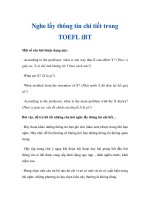Nghe lấy thông tin chi tiết trong TOEFL iBT doc
Bạn đang xem bản rút gọn của tài liệu. Xem và tải ngay bản đầy đủ của tài liệu tại đây (119.49 KB, 4 trang )
Nghe lấy thông tin chi tiết trong
TOEFL iBT
Một số câu hỏi thuộc dạng này:
· According to the professor, what is one way that X can affect Y? (Theo vị
giáo sư, X có thể ảnh hưởng tới Y theo cách nào?)
· What are X? (X là gì?)
· What resulted from the invention of X? (Phát minh X đã đem lại kết quả
gì?)
· According to the professor, what is the main problem with the X theory?
(Theo vị giáo sư, vấn đề chính của thuyết X là gì?)
Bởi vậy, để trả lời tốt những câu hỏi nghe lấy thông tin chi tiết…
· Hãy tham khảo những thông tin bạn ghi chú (take note) được trong khi bạn
nghe. Hãy nhớ, đề bài thường sẽ không hỏi bạn những thông tin không quan
trọng.
· Hãy tập trung chú ý ngay khi đoạn hội thoại hay bài giảng bắt đầu bởi
thông tin có thể được cung cấp dưới dạng quy nạp – định nghĩa trước, khái
niệm sau.
· Đừng chọn một câu trả lời nào đó chỉ vì nó có một vài từ có xuất hiện trong
bài nghe, những phương án lựa chọn kiểu này thường là không đúng.
· Nếu bạn thực sự không chắc đâu là câu trả lời chính xác, hãy chọn phương
án nào phù hợp nhất với ý chính của đoạn hội thoại hay của bài giảng.
Ví dụ:
Professor: Uh, other things that glaciers can do is, uh, as they retreat,
instead of depositing some till, uh, scraped up soil, in the area, they might
leave a big ice block and it breaks off and as the ice block melts it leaves a
depression which can become a lake. These are called kettle lakes. These
are very critical ecosystems in this region, um because uh uh they support
some unique biological diversity, these kettle lakes do.
The Great Lakes are like this, they were left over from the Pleist- from the
Pleistocene glaciers, uh, the Great Lakes used to be a lot bigger as the
glaciers were retreating, some of the lakes were as much as a hundred feet
higher in elevation. The beach of a former higher stage of Lake Erie was
about fifty miles away from where the beach- the current beach of Lake Erie
is right now. So I just wanted to tell you a little bit more about glaciers and
some positive things uh that we get from climate change, like the ecosystems
that develop in these kettle lakes, and how we can look at them in an
environmental perspective …
Question 1: What are kettle lakes?
A. Lakes that form in the center of a volcano
B. Lakes that have been damaged by the green house effect
C. Lakes formed by unusually large amounts of precipitation
D. Lakes formed when pieces of glaciers melt
Question 2: How did the glaciers affect the Great Lakes?
A. They made the Great Lakes smaller
B. They made the Great Lakes deeper
C. They reduced the biodiversity of the Great Lakes
D. They widened the beaches around the Great Lakes
Giải thích:
Đáp án cho câu hỏi 1 nằm ở ngay phần đầu tiên của bài giảng, khi vị giáo sư
giải thích kettle lake được hình thành ra sao “…Uh, other things that
glaciers can do is, uh, as they retreat, instead of depositing some till, uh,
scraped up soil, in the area, they might leave a big ice block and it breaks off
and as the ice block melts it leaves a depression which can become a lake.
These are called kettle lakes…”. Như vậy phương án thứ tư là câu trả lời
chính xác nhất cho câu hỏi này. Điều cần lưu ý ở đây là dạng câu hỏi lấy
thông tin chi tiết thường tập trung vào các thuật ngữ mới như kettle lake.
Bạn có thể tìm thấy đáp án cho câu hỏi số 2 trong phần sau của bài nghe,
“…the Great Lakes used to be a lot bigger as the glaciers were retreating,
some of the lakes were as much as a hundred feet higher in elevation. The
beach of a former higher stage of Lake Erie was about fifty miles away from
where the beach- the current beach of Lake Erie is right now…”. Hãy lưu ý
các cấu trúc câu được sử dụng ở đây: Used to thường diễn tả một điều gì đó
đúng trong quá khứ và không còn như vậy ở hiện tại. Quá khứ tiếp diễn
(were retreating) thường diễn tả một hành động gì đó đang xảy ra tại một
thời điểm nào đó trong quá khứ. Nếu nghe hiểu được câu tiếp theo, bạn sẽ dễ
dàng tìm ra đáp án cho câu hỏi này.









